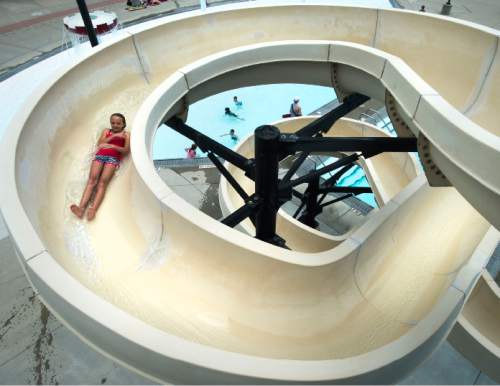This is an archived article that was published on sltrib.com in 2016, and information in the article may be outdated. It is provided only for personal research purposes and may not be reprinted.
A bill that proposes to use economics to encourage water conservation is touring the Utah Legislature rapidly.
SB28 would require retailers of culinary drinking water — municipalities, for the most part — to establish inclining fee schedules that increase the per-unit price of water according to the customer's use. There's no mention of how much the price of water should increase, but the bill's sponsor, Sen. Scott Jenkins, R-Plain City, has said these kinds of fee schedules are proven means of persuading consumers to use less water.
"This is simply our effort to try to encourage water conservation through pricing, which is proven to be very efficient," he said.
The bill has already passed the Senate with a 26-2-1 vote — Sen. Curt Bramble, R-Provo, did not vote; Sens. Mark Madsen, R-Saratoga Springs, and Peter Knudson, R-Brigham City, opposed the bill. It's now on its way to the full House after a committee hearing offered a unanimously favorable recommendation.
Zach Frankel, the executive director of the Utah Rivers Council and an advocate for conservation pricing, said the bill is "a step in the right direction," and he expects it will make the legislative rounds quickly.
"It shouldn't generate too much opposition," he said. "It's not going to have giant fiscal notes and shouldn't lead to increased water bills — except for very large water users."
Adam Diehl, a local urban farmer who grows produce like microgreens, tomatoes and cabbage in his greenhouses, questioned whether the bill's proponents have thought about how increased rates would impact farmers.
"If my rates go up — and I'm already trying to be very careful about how much water I use — if my costs go up, I have to pass that on to someone else," he told The Tribune. "Four dollars for a pound of tomatoes is a pretty good price. Are you willing to pay $5?"
At some point, Diehl said, rising water rates coupled with other costs could make it difficult for Utah producers to compete with imported products, making local food more difficult to find. Costs in the Salt Lake area already are forcing growers out, he said.
Most communities on the Wasatch Front have moved to a tiered schedule. A 2010 survey conducted by Westminster College and Utah State University estimated that just over half of the communities in Salt Lake County had tiered water schedules.
Cities that haven't adopted inclining fee schedules weren't keen on having the state force a change — but it's not because they're against saving water, they said.
Murray already has a conservation system in place, said Danny Astill, the city's superintendent of water. Murray uses a seasonal price structure that increases the rate per 100 cubic feet of water in the summer, when demand peaks.
"We believe that has been very successful, and we haven't felt the need to go to a tiered rate system," he said. "I don't know that it would or wouldn't work any better. We believe that this has been a very simplified approach that has worked as well or better than those who have used the tier, and without customer complaints."
Astill said Murray adopted its conservation rates when the governor challenged the state to reduce its water use by 20 percent. With the new rates and an education system in place, Astill said, Murray saw a 20 percent reduction in the first six or seven years.
"We believe that cities or districts or wherever should have the ability to … structure their rates to what's appropriate for them," he said.
The town of Alta charges according to water fixtures, with different values assigned to everything — from sinks, toilets and showers to pools and hot tubs, said Kate Black, the town clerk.
In Alta — which has a population of just a few hundred but is a popular skiing destination — water users are allotted an amount of water based on the number and type of fixtures on the property, and then charged a flat annual rate for that base allotment. Those who exceed their annual allotment are charged significant overage fees, she said.
Black said that a lengthy study and series of town hall meetings went into developing the unusual water schedule, a process that ensured most everyone in town felt the new rate was fair.
"I'm not sure having a blanket approach for all towns in Utah is the way to go," she said. "Every single water system is so unique — rural communities, special districts. I think they're trying to promote conservation, and I totally embrace that, but I am not sure that 'one rule fits all' is the way to do it."
Alta's system successfully conserves water, she said. Initially, some of the town's water users would incur overage fees regularly, but over time, the stiff fines encouraged users to put in low-flow water fixtures and make other upgrades to eliminate the overages.
Today, she said, overages are rare and the town has cut its overall water use in half.
"Our town embraces this 100 percent and does everything possible, without taking away from the ambiance of these hotels, to conserve water," Black said.
Cities that have adopted tiered schedules are just as adamant about their systems. Ogden adopted an inclining tiered rate almost two decades ago, and water managers there have found it an effective tool for deterring waste.
"You can teach and teach and teach about the things," said Kenton Moffett, public utilities manager for Ogden, "but a lot of the time money is that powerful deterrent.
There are always complaints whenever the price for a commodity like water increases, Moffett said, but the impact to the typical residential user in Ogden has been minimal. The average Ogden water bill runs about $30.17 per month, while the monthly bill in other Western states can average as much as $300 per month, he said.
But government regulation can only go so far, said Roger Thomas, a Midvale economist who works as a consultant. Price controls and mandates will curb use only to a point, he said. If the state really wants people to value water for the scarce resource it is, the taxes that subsidize water delivery in Utah should be eliminated, he said.
"Unless [the state] found a way to cut costs, user fees would go up for sure," Thomas said.
The bill is a little hollow because it has nothing to say about how the new fee schedule should be implemented, said Frankel, of the Utah Rivers Council.
"If the Legislature tried to institute meaningful rate structures, they would have a very steep hill to climb," he said. "Maybe one day we could come back and do that. That would be fantastic. But Utahns probably aren't ready for that, even though it would be in our best interest."
Twitter: @EmaPen
This story was also informed by sources in the Utah Public Insight Network. To become a news source for the Tribune, visit sltrib.com/upin.







